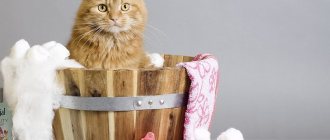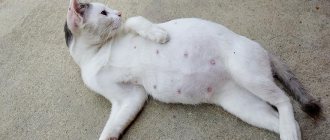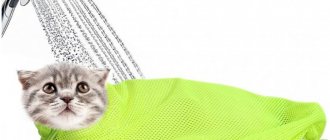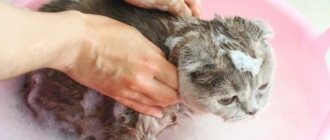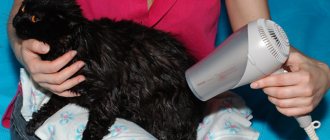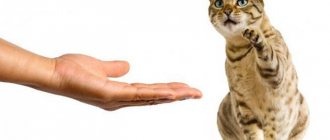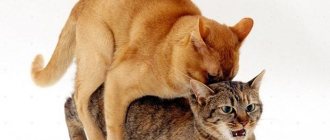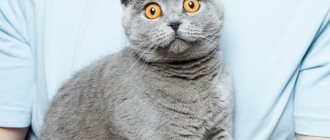Is it suitable for cats?
In addition to special shampoos intended for hair and skin care, there are drugs whose action is aimed at destroying parasites or fungus. Many cat owners refuse pharmaceutical products, preferring tar soap, because... this product has a number of useful properties.
When used correctly, this soap accelerates the process of cell regeneration and relieves irritation of the epidermis. It has anti-inflammatory and antibacterial effects. The smell of a hygiene product can repel parasites, which serves as a prevention of flea infestation.
But tar soap cannot be used regularly for the procedure either. The choice in favor of this product should be made if there is no special means for washing the animal at home.
Does it help remove fleas?
Soap containing birch tar does not provide a 100% guarantee of killing parasites. The product will only be effective under certain conditions. For example, if a cat has been in contact with another animal that has fleas, then preventive treatment is required immediately after a walk.
It is necessary to bathe the pet. If he was infected, then 1 procedure will be enough. Parasites can be washed or combed out. Benzene, which is contained in tar, is a toxin for insects. It affects the nerve centers of fleas. Therefore, the parasites become lethargic (sedentary).
If a cat has a severe flea infestation, then several treatments will be required to treat head lice. The animal must be soaped and wait 5 minutes. During this time, some of the fleas will leave the fur on their own (will end up in the water), while others will become inactive. The remaining parasites are combed out.
But soap only has a negative effect on adults, and not on their eggs. Therefore, it will be necessary to re-treat in a few days when the nits hatch.
Disinsection of premises
Rules for disinfestation of premises:
- If you have an animal, you need to wash the floors in your house every day. To eliminate flea larvae in an apartment, add vinegar to the water. Use the resulting solution to wash the floors and wipe the furniture and bedding of the animal with a damp cloth. For 1 liter of water you will need 1 tbsp. l. vinegar.
- It is recommended to place fresh wormwood and mint in the corners of the apartment. This smell repels insects.
- To re-treat the room, it is recommended to add chlorine-containing products to the water.
- After getting rid of fleas, the animal's bedding must be thoroughly washed at a temperature of 90 degrees. Then iron it with an iron.
- To prevent the reappearance of fleas, it is recommended to spray the room and furniture with a soda solution. For 1 liter of warm water 1 tbsp. l. facilities.
Fresh mint is a good remedy for killing fleas in an apartment.
Attention! If the animal has a lot of fleas, then professional help may be required to thoroughly disinfest the premises.
Is it effective against lichen?
Tar reduces the activity of bacterial and fungal microflora, so soap containing this element can be used to treat lichen in cats. To cure an animal, apply foam to the affected area and leave for 15 minutes.
You can also make pasta. You will need to rub the bar, fill it with warm water, and then wait until the crushed particles are completely dissolved. You should get a homogeneous mass. It is applied daily to the lichen, and after 15-20 minutes it is washed off with water.
Sulfur-tar ointment
For a dermatological disease, a veterinarian may recommend sulfur-tar ointment. In addition to tar, it contains substances that will help speed up the process of treating lichen (turpentine, lanolin, sulfur, zinc oxide, salicylic acid, Lysol and petroleum jelly).
Before use, the cat’s hair is not cut. The ointment is applied to the affected area, and also treated 2-3 cm beyond the contour of the lichen (around). Forcibly, i.e. You cannot remove the crusts yourself. The site of infection is treated 1-2 times a day.
In most cases, a positive result is observed on the 7-10th day of treatment. The crusts begin to separate, and the hairline is restored (grows).
Harm and contraindications
Soap containing tar is considered a fairly safe product, but also has contraindications. It is not recommended for washing kittens that are not yet 6 weeks old. You should refrain from using the hygiene product if the cat has an individual intolerance to tar or other components included in its composition.
Soap can be harmful to your cat if the foam gets into your cat's eyes. It will cause pain. To eliminate the irritating factor, the animal's eyes are washed with clean water. If soap gets into the mouth or digestive tract, your pet may experience symptoms of stomach upset. Sometimes he can be lethargic.
If an animal has eaten a lot of soap, then it shows signs of poisoning. In such a situation, you need to take the cat to the veterinarian. Gastric lavage may be required.
Frequent use of soap can cause dermatological problems. Despite the antiseptic, wound-healing effect, the hygiene product dries out the skin. Therefore, with frequent bathing, the cat may experience irritation from drying out of the epidermis.
About the Demodex mite
There are two species of these mites found on humans: Demodex folliculorum and Demodex brevis.
Demodex mites can also live on various types of animals, in particular on dogs, which also suffer from demodicosis. But a person cannot become infected from an animal, since those ticks belong to other species and cannot live on humans. Demodex mites are considered opportunistic. This means that they can live on the skin of a healthy person - their presence does not always lead to the development of the disease. Different studies indicate different prevalence of Demodex. In any case, at least 50% of people are carriers of these mites; some researchers put the figure at 97%. It is believed that among children and young people there are fewer carriers of Demodex mites, the number of carriers increases with age, and almost all older people are affected by this mite.
Demodex lives in the sebaceous glands and hair follicles, preferring the face to other parts of the body. Larger mites, Demodex folliculorum, most often target the hair follicles of the eyelashes and eyebrows. Demodex brevis prefers to settle in the sebaceous glands of the wings of the nose, nasolabial folds, and chin. However, mites can also be found on other areas of the skin, including the cheeks, neck, chest and back.
Demodex mites are not visible to the naked eye. An individual of Demodex folliculorum can reach a size of 0.5 mm; Demodex brevis is even smaller - no more than 0.15 mm. Demodex does not like light and is most active at night. The most comfortable temperature for it is 30-40 °C, so the tick becomes active in the spring and summer.
Shampoo
Tar shampoo intended for animals can be purchased at a veterinary pharmacy, pet store or supermarket, i.e. the product is publicly available. This product is often marketed as a flea and tick product. You can choose from:
- Celandine;
- Magic pet;
- Doctor;
- Luxury;
- Degtyarny (Nevskaya cosmetics);
- Home doctor.
The difference between shampoo and soap may be in the composition, but not always. Additional substances, such as dyes or fragrances, are often added to the first product. Not all of them are safe for the animal, because... may cause an allergic reaction.
When choosing between soap and shampoo, you should carefully study the composition. If the cat does not have individual intolerance to the components, then you can use any form of release.
Many owners prefer to use shampoo because... it's easier to apply.
Safety of use
- If there are signs of an allergic reaction, both in animals and humans, stop using the drug immediately.
- Disinfection is not recommended for women expecting babies. Sensitivity to any of the components may cause nausea and vomiting.
- The room where anti-flea therapy is carried out must be ventilated. Since the smell remains on the wool for 24-48 hours, it is necessary to maintain air circulation to avoid headaches, dizziness, and disorientation in space.
If you find fleas on your pet, you should not rush to buy newfangled drops, powder or sprays. Drug intervention is not always justified. Proper use of tar soap will help your pets recover from illness in a simple and painless way.
How to wash?
The cat can be bathed 2 times a month. Water procedures should be abandoned if the animal:
- pregnant;
- sick;
- was recently vaccinated.
If the pet has just eaten, then it is better to postpone bathing for 2-3 hours.
To make the cat feel comfortable during water procedures, preference should be given to a small bath. You need to lay a rug on its bottom. It will prevent the animal's paws from slipping. Water is drawn up to the level of the pet’s chest. It should be warm, not exceed +38°C.
The cat is lowered into the prepared bath. It is not recommended to collect water while the animal is inside. This bathing option is suitable for pets who love such procedures.
The animal's fur is well moistened with water and then soaped. Shampoo or soap containing tar is immediately applied to the coat. There is no need to pre-dilute the detergent in water. It is not recommended to wet or soap your hair.
For the product to work, it must be left on the fur for 5-10 minutes. When the time is up, the animal is rinsed with clean water. The foam is washed thoroughly. It should not remain on the fur, because... may get on the mucous membrane.
When the water procedure is completed, the cat is wrapped in a dry towel and taken to a warm room. Additionally, you can turn on the heater to prevent your pet from freezing. You should not let the animal out of the warm room until it is dry. Otherwise, there is a risk that the cat will get sick.
Pediculosis in children: an endless story
Home — Social networks — Pediculosis in children: an endless story
Pediculosis in children has long ceased to be a purely social phenomenon. According to statistics, in the fall the main centers of outbreaks of head lice are schools. And lice are brought there not by the children of alcoholics, but by tanned and rested children from wealthy families on distant shores. Most cases of head lice are registered in children who have been on vacation in England, France, that is, in developed European countries. How is this possible? I'll tell you now. And at the same time I’ll tell you my story of treating head lice in a child with long thick hair.
PEDICULOSIS IN OUR CHILDREN - LET'S NOT BE POODS
Whatever you say, lice in children, or, more simply, “lice,” is a parasitic disease that brings not only physical discomfort, but also certain “moral suffering.” In our society, there is a widespread belief that lice is a disease of unscrupulous people, homeless people and other “rabble.” It is believed that in a decent family a child cannot get sick with anything like this. And if lice are discovered, this fact must be hidden from all friends and neighbors. Otherwise, what a shame...
Such silence ends with lice wandering from one child’s head to another with complete impunity. It is not possible to find out the source of lice infestation, because even good neighbors will not tell you that their children (your child’s friends) returned from summer vacation with lice. In the best case, you will receive this valuable information after this becomes your reality. Then, as more experienced neighbors, they will begin to give valuable advice on how to treat pediculosis.
“Your girl has lice,” the class teacher said, taking me aside on the second day of school. After which I found myself with a note from the school nurse, which included a diagnosis of head lice and a ban on attending classes without a certificate from the clinic. “God, where from?!” — that’s all I could say then. I was very ashamed...
And in vain. Later I found out that head lice in children is not as rare as people think. Every autumn, at the beginning of the school year, lice are found on average in 15-20 children per thousand primary schoolchildren, and this is only what is officially registered by clinics. After all, many parents carefully hide the fact of infection from others because of shame: they don’t even go to the pediatrician, but treat lice at home with all sorts of folk remedies.
In the fall, schools become the main foci of head lice. Lice are brought into the classroom mainly by children from wealthy families. According to Rospotrebnadzor, in 2006, the incidence of head lice in children after the summer jumped 2.5 times compared to previous years, primarily due to those who traveled abroad in the summer. But these are data from 2006, and not some modern propaganda in retaliation for sanctions.
PEDICULOSIS IN CHILDREN IN EUROPE IS THE NORMAL, BUT YOU DIDN’T KNOW?
Old lady Europe is the one who most willingly shares her lice with us. Moreover, not just any Bulgaria or Montenegro. It turns out that the most lice-infested country in Europe is Great Britain. Pediculosis in children in English schools and camps is common. At the same time, no one declares a quarantine and, imagine, no one isolates lousy children. In summer camps, where children are under the supervision of teachers, they are simply treated with special anti-lice products, which, by the way, are very effective, according to the reviews of the “victims.” If lice are found on children during the school year (the peak is in the fall), the parents of the students only receive notifications that there is lice at school. What they do with this information is their own business. The teacher can only recommend that they treat the child for lice, because it... interferes with the student’s ability to work in class, and not at all because he can infect other children. As a result, in the Kingdom of England, primary school students, regardless of their social status, get lice up to 5 times a year! And you say “princesses don’t poop...”
In Denmark, head lice is also “all right.” To such an extent that “lousy Saturdays” are held in this country, promoting the fight against these bloodsuckers. Moreover, it was in Denmark that a special comb-shaped attachment for a vacuum cleaner was invented to collect lice from heads. The author of the invention is a school teacher. Can you imagine the scale of lice if lice can already be removed from children with a vacuum cleaner?
In France, if you believe our compatriots who went there for permanent residence, lice are also treated without validol: well, a child has lice, so what? “I often stand at a traffic light next to a pharmacy. The window display changes every season. In winter they advertise vitamins, in spring - weight loss products, in summer - sunscreens. And in the fall, the window is decorated with a scout with a bullhorn. He trumpets: “The lice are back!” Sometimes, instead of a scout, the window depicts giant lice, which are being chased by giant cans of all kinds of anti-lice poison,” wrote a Russian mother living in Toulouse on one of the forums. Her own children contracted head lice in the first week of the school year. But naive Russian parents only realized this when leaflets were distributed to everyone at school: “Dear parents, there are lice in the school, treat your child’s head, as well as hats and bed linen.” And, please note, there is no talk of any quarantine, or of any removal of children with head lice from school.
No less indicative is another story of Russians, whose children became infected with pediculosis during a trip to Spain. While traveling around the country, they were supposed to stay with friends, but found it inconvenient given the circumstances. Imagine their surprise when their friends shrugged their shoulders in response and said: “What’s wrong with that? Stop by our pharmacy on the way.”
Why is this attitude towards pediculosis in Europe? Perhaps because these days all the diseases that lice have been carriers of for centuries have been practically defeated. The lice bite itself is not dangerous to humans if it is not infected. But if not... In the past there was even a sign: lice appear in the house of a deceased person. Creepy, right? But if we remember that in those distant times lice were carriers of typhus, then the logic of this “sign” becomes obvious. Fortunately, now the likelihood of catching this infection from lice has been reduced to zero. So many Europeans treat lice like mosquitoes. And they begin to remove them only when they already cause significant discomfort.
Our situation is completely different. Pediculosis in our society is like leprosy before. If you tell someone, ten meters of a sanitary zone around the child will be provided. In this case, you are obliged to isolate the child from society, and while the doctor, inspecting the results of treatment for head lice, finds at least one live nit on the hair, there can be no talk of any visit to school or kindergarten. So, we sat at home to get treatment.
PEDICULOSIS IN CHILDREN: WHAT TO TREAT IF YOU ARE “LUCKY”
In my childhood, treatment for head lice was limited to the use of dust, kerosene and tar soap. I remember how I wanted to climb the wall from the smells of these products. Fortunately, both dust and kerosene, despite their effectiveness, are today considered unjustified barbarism. And tar soap, contrary to its image, is considered useless. From the pediatrician I received a list of how to treat head lice in children with the words that all drugs work, choose what you can afford.
Of course, the simplest and most effective method of dealing with lice in a child is shaving. Insects do not live on a bald head and, most importantly, cannot reproduce, since they attach their eggs in the root zone of the hair. No hair - no nits, no nits - no new lice. If I had a boy, the story would end there... But shaving a girl, and a first-grader at that, is humiliating. My daughter’s hair was thick and long, and I decided that I would not cut my child’s hair short, much less shave him bald.
Of course, this decision made our fight against head lice more difficult. We spent 2 weeks completely removing this infection. I think if I had at least some experience in this area, and I would have thought even for a minute that my clean child was scratching his head because there were lice, the scale of the disaster and the time frame for its elimination would have been less. But I was captive of the mass illusion that well-groomed children at home these days do not get lice. The result of this misconception resulted in 14 days of hassle.
Initially, we were determined that we could get rid of lice in a week at most. The treatment plan for head lice was as follows: kill lice and nits using treatment, comb out the hair, re-treat on the seventh day and show the doctor a clean head. But it was not there. During the examination, the pediatrician discovered several living nits (they, you know, make a characteristic cracking sound under the nails, unlike dead ones). And she sent us to receive further treatment. It was then that I realized that the selected remedy for head lice, even the best one according to reviews, was not enough.
What helped us cope with head lice in a child with long hair:
1. TREATMENT WITH PHARMACEUTICAL PRODUCTS FOR PEDICULOSIS.
You should not believe promises that the product will remove both lice and nits. From my own experience I can responsibly declare: this is not so. Pharmacy chemicals do not kill nits! They act on lice by suffocating, paralyzing and dehydrating living parasites. But nits are eggs, they don’t breathe (contrary to the claims of some advertising brochures), so they don’t care about such chemistry. Most drugs for the treatment of pediculosis, which are written “destroy lice and nits,” actually kill only lice, and you are asked to comb out live nits by hand with a special comb included in the kit. If you carefully study the composition of such preparations for head lice, then, in addition to the main active ingredient, they contain oils or alcohols that soften or dissolve the glue that securely attaches nits to the hair, making them easier to comb out. I personally have not found any drugs that actually kill nits on our pharmacy shelves. There are enough of them stated. But the actual effectiveness is questionable to spend the family budget on them. I’ll tell you below how we “peeled off” the nits.
Of the commercial products for the treatment of pediculosis, I will single out two at once, because their alternate use on the advice of a second pediatrician, whom we came to after the first week of unsuccessful treatment, helped us. Firstly, this is the Para Plus spray, which contains not one, but three active ingredients. Secondly, Paranit shampoo (namely shampoo), contains mineral oil and does not contain insecticides, so it combined perfectly with the first remedy without the danger of poisoning the child along with lice. The advantage of this shampoo is the fine comb included in the kit. It was with this that we combed out the nits after treatment. We alternated Para Plus and Paranit at intervals of 3-4 days, instead of using one at a time every week.
2. COMBING OUT LICE AND NITS.
Combing for lice is the only 100% way to remove lice and nits. Moreover, without combing out nits, all your efforts to combat lice will be in vain. After treating your head with a special product, be sure to comb your hair with a thick comb (they are sold in pharmacies both separately and as a set with various medications for head lice). This way you can understand the scale of the infestation and monitor the dynamics: how many lice are combed out the first time, how many after a few days, after a week (ideally, not a single one). I do not recommend spending money on expensive miracle lice combs advertised on the Internet. There is nothing special about them except the price. This is such a “mess from an axe” - without treating the hair with products that soften the nit glue, all these combs are ineffective. And after treatment, any metal nit comb that comes with the lice remedy can handle combing.
After trial and error, we found that a vinegar solution works best on glue. Cheap and cheerful. The essence of the method is simple: take 9% table vinegar (under no circumstances use vinegar essence!) and dilute it in a ratio of 1:2, that is, 1 part vinegar to 2 parts water. This solution is used to treat dry hair along its entire length, starting from the roots. The easiest way to apply the vinegar solution is with a sponge. In this case, you need to try to ensure that as little vinegar gets on the scalp as possible. But if it hits, it’s tolerable. After treatment, all hair should be hidden under a bag or rubber swimming cap. This is done so that the vinegar does not evaporate ahead of time. Action time: 30 minutes. On the Internet you can read recommendations to keep the vinegar solution on your head for at least an hour. But, in practice, half an hour is enough to get the desired effect without burning the child’s scalp in a vinegar bath. After 30 minutes, carefully comb your hair from roots to ends with a special comb. Important: the combing procedure after vinegar is best done in the bathroom. This is done so that adult lice, stupefied by vinegar, do not fall onto clothing or the floor when combed out, which would lead to re-infection. After each pass through the hair, the comb should be rinsed with running water so as not to return the newly combed nits back into place. It is better to carry out treatment once every 3-4 days. Especially if you decide to follow the same difficult path as we did - at all costs to preserve your child’s long, thick hair. By the way, instead of table vinegar, you can use 3% apple cider vinegar. Or hellebore water, which also has a beneficial effect on hair. But at that time, hellebore water turned out to be in short supply in pharmacies. So, we made do with table vinegar.
3. WASHING AND TREATING ALL THINGS.
Everything that could be washed went into the wash at 60 and 90 degrees (lices and nits die at 50-55 degrees, and at 40 you just give them a bath). Everything that could not be washed in hot water, or simply could not be put into the washing machine, was treated with A-Par spray: pillows, mattresses, a sofa, a carpet in the nursery, hats, etc. The floors throughout the apartment and other surfaces were washed with a solution of table vinegar.
AGGRAVATING CIRCUMSTANCE: PEDICULOSIS AND BREASTFEEDING
At the time when my eldest daughter was diagnosed with lice, the youngest was only 2 months old, and I was breastfeeding her. My baby, fortunately, did not have time to become infected, despite close contact with my sister. But I, although not very much, was hooked... What should a nursing mother do if all remedies for lice are contraindicated while breastfeeding? Permanent hair dye to help you. Not the gentle one, but the one that contains hydrogen peroxide. Hydrogen peroxide (H2O2) burns both lice and nits. And in weak concentrations it dissolves nit glue. Therefore, if you dye your hair with hydrogen peroxide (contained in most lightening and highly lightening dyes), and after dyeing, rinse your hair thoroughly and comb it with the same fine-toothed comb, then the chances of getting rid of lice in one go will be very high. In my case, this is what happened. I can recommend the same method if pediculosis is detected in pregnant women. It is strictly forbidden for the expectant mother to be treated for lice with insecticidal preparations. And you can paint your head with permanent paint at any time.
P.S
Where exactly my daughter became infected with lice remains a mystery to me. But since then, every summer I carefully examine her head several times a month. Especially before the start of the school year. And since then we have another taboo: on loose hair outside the home. For prevention. In Europe, lice are no longer considered a disease, but in our country, lice on a child are a shame and disgrace for his parents, no matter what you say. Maybe it is precisely this disgust towards lice that saves us from such a shocking lice infestation as in Europe?
Reviews
Svetlana Vasilievna, 46 years old, Moscow:
“At the dacha, the cat picked up shingles somewhere. Due to the lack of opportunity to go to the city, i.e. to a veterinary pharmacy, I had to turn to traditional medicine methods. Apply tar soap foam to the affected area, rub in, and then wash off.
Additionally, after each soaping, I treated it with iodine. In this way, we managed to cure lichen in a week.”
Ivan Markovich, 77 years old, Novosibirsk:
“There were always cats at home, 2-3 each. Therefore, I had to deal with the problem of fleas more than once. When signs of parasites were noticed in one of the pets, everyone was immediately bathed with tar soap.
Now there is one cat living at home, which has access to the street. I also bathe her periodically with tar, but this time with shampoo, because... it is more convenient to use. A positive result is always visible after 1-2 procedures.”
Marina Sergeevna, veterinarian, Petro.
What to replace it with?
For bathing adults and kittens, it is better to use special products that are intended for animals. When making them, the pH of the pet's skin is taken into account. When choosing a hygiene product, you should always look at the manufacturer’s information about the age at which a cat can be bathed and any contraindications.
If you don’t have tar shampoo or soap at home, and you can’t purchase a special veterinary remedy, dust soap is a good remedy for parasites and skin diseases. This product allows you to destroy not only fleas, but also their eggs.
Tar shampoo, like soap, has a repulsive odor. It is unpleasant not only to insects, humans, but also to the cat itself. For this reason, you should not keep the animal lathered with this composition for a long time.
After bathing, you should not try to mask the smell of soap with another product, such as perfume. For your pet, this aroma will also be unpleasant and irritating. It is necessary to allow the cat to tidy up its fur on its own (by licking).
Which is better: chemical flea preparations or folk remedies?
The main advantage of folk methods of getting rid of blood-sucking insects is accessibility. Almost every home has garlic, and you can buy chamomile, wormwood essential oil or herbal mixture at the nearest pharmacy or supermarket.
Using folk remedies (especially oils, wormwood or garlic), prepare for a strong and persistent smell in the house. Some animals (especially puppies and kittens) do not tolerate them well. Oils can cause allergies or rashes, and some substances (tansy, boric acid and vinegar) can cause severe poisoning. When using such drugs, you should be especially careful, follow the recommended dosages and monitor the behavior and condition of your pet.
Under no circumstances should your pet be allowed to lick its fur: even a small amount of herbs and oils with a strong odor can cause vomiting, diarrhea and worsening of the condition. Traditional methods of getting rid of parasites are safer in this regard: shampoos, sprays, tablets and drops on the withers.
Many products are very inexpensive, but do not cause allergies or side effects. They can be used even by babies (from 2 weeks), nursing and pregnant cats and dogs. Such products are also made on the basis of natural ingredients, herbs and oils, which care for the coat and make the combing process easy and enjoyable.
Immediately after identifying fleas on an animal, you must begin to fight them.

